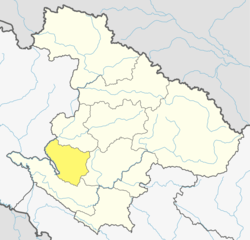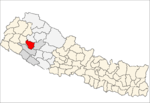Dailekh District
Dailekh District (Nepali: दैलेख जिल्ला;![]()
Dailekh District दैलेख जिल्ला | |
|---|---|
District | |
Entrance gate to Dailekh | |
 Location of Dailekh District (dark yellow) in Karnali | |
| Coordinates: 28°50′15″N 81°42′28″E | |
| Country | |
| Province | Karnali Pradesh |
| Admin HQ. | Dailekh (Narayan) |
| Municipality | |
| Government | |
| • Type | Coordination committee |
| • Body | DCC, Dailekh |
| • Head | Mr. Prem Bahadur Thapa |
| • Parliamentary constituencies | 2 seats List
|
| • Provincial constituencies | 4 seats List
|
| Area | |
| • Total | 1,505 km2 (581 sq mi) |
| Highest elevation | 4,168 m (13,675 ft) |
| Lowest elevation | 544 m (1,785 ft) |
| Population (2011)[1] | |
| • Total | 260,855 |
| • Density | 170/km2 (450/sq mi) |
| Demographics | |
| • Ethnic groups | Chetri, Kami, Thakuri |
| • Female ♀ | 51% |
| Human Development Index | |
| • Literacy | 62% |
| Time zone | UTC+05:45 (NPT) |
| Postal Codes | 21600, 21602, 21603, 21604, 21605, 21607..., 21610 |
| Telephone Code | 089 |
| Main Language(s) | Nepali |
| Major highways | Mid-Hill (under cons.) |
| Website | ddcdailekh.gov.np |
Etymology
It is said that the name Dailekh is derived from Dadhi Lekh. Dadhi stands for Dadhichi. Dadhichi was a sage in ancient time and Lekh mean hill. Etymologically ‘Dadhi Lekh’ means the hill where sage Dadhichi meditated.[4][5] There is also another story about name that, in ancient time it was a place of Devatas, so it called "Daibalok" which later became 'Dailekh'.[4][5]
History
Dailekh District was a part of Khasa kingdom during 12th to 14th century.[6] Sinja Valley was the ancient capital city and powerful town of the Khasa Kingdom[7]:76[8] After the fall down of the Khasa Kingdom it divided into many small kingdoms. Before the unification of modern Nepal, the area of the Karnali region had a united kingdom named Baise Rajya (Twenty two principalities). Dailekh principality was one in twenty two principalities.
Geography and climate
Dailekh is a high, hilly district out of ten districts of Karnali Province. It is situated at coordinates of 28° 35' 00" N to 29° 08' 00" N Latitudes and 81° 25' 00" E to 81° 53' 00" E of Longitudes. The lowest elevation is 544m and the highest elevation is 4,168m. The headquarter is situated at an elevation of 1448m. The district has covered 80% of mid-hill land and 21% of high-hill land. The total area of the district is 1,505 square kilometres (581 sq mi).[5]
On the basis of altitude,this district can be classified into 4 different sub-categories:
| Climate Zone[9] | Elevation Range | % of Area |
|---|---|---|
| Upper Tropical | 300 to 1,000 meters 1,000 to 3,300 ft. |
16.7% |
| Subtropical | 1,000 to 2,000 meters 3,300 to 6,600 ft. |
64.5% |
| Temperate | 2,000 to 3,000 meters 6,400 to 9,800 ft. |
16.1% |
| Subalpine | 3,000 to 5,500 meters 9,800 to 18,044 ft. |
2.4% |
Transportation
Dailekh is connected with Birendranagar (the capital city of Karnali Province) with a road called Dailekh road (F-48). Dailekh road meets to Ratna Highway (NH-12) at Birendranagar (Surkhet). Ratna Highway is connected with Mahendra Highway (NH-1) at Kohalpur. Through Mahendra Highway one can get access to Kathmandu, Pokhara and other cities of Nepal.
There is another road connecting Dailekh to Karnali Highway (NH-13) via Dullu.
The national capital Kathmandu is at distance of 647.41 kilometres (402.28 mi) from Dailekh.
The nearest airport for Dailekh is Surkhet Airport which is about 70 kilometres (43 mi) at distance from Dailekh.
Demographics
At the time of the 2011 Nepal census, Dailekh District had a population of 261,770. Of these, 97.9% spoke Nepali and 1.5% Magar as their first language.[10]
Constituency
Dailekh comprises 2 parliamentary seats and 4 provincial seats:
| Constituency | Area | Seat | MP/MLA | Party |
|---|---|---|---|---|
| Dailekh 1 | Parliamentary | Rabindra Raj Sharma | Nepal Communist Party | |
| Dailekh 2 | Parliamentary | Raj Bahadur Buda Chhetri | Nepal Communist Party | |
| Dailekh 1(A) | Provincial | Dharma Raj Regmi | Nepal Communist Party | |
| Dailekh 1(B) | Provincial | Amar Bahadur Thapa | Nepal Communist Party | |
| Dailekh 2(A) | Provincial | Sushil Kumar Thapa | Nepal Communist Party | |
| Dailekh 2(B) | Provincial | Raj Bahadur Shahi | Nepal Communist Party |
Divisions of Dailekh
As per the new constitution of Nepal 2015, the district is divided into 4 urban municipalities and 7 rural municipality;
| # | Municipality | Type | Area | Population | Website |
|---|---|---|---|---|---|
| 1 | Narayan | Urban | 110.63 | 27,037 | narayanmun |
| 2 | Dullu | Urban | 156.77 | 41,540 | dullumun |
| 3 | Aathbis | Urban | 168 | 29,227 | aathbismun |
| 4 | Chamunda Bindrasaini | Urban | 90.6 | 26,149 | chamundabindrasainimun |
| 5 | Thantikandh | Rural | 88.22 | 18,896 | thantikandhmun |
| 6 | Bhairabi | Rural | 110.46 | 21,233 | bhairabimun |
| 7 | Mahabu | Rural | 110.8 | 19,277 | mahabumun |
| 8 | Naumule | Rural | 228.59 | 20,802 | naumulemun |
| 9 | Dungeshwar | Rural | 105.19 | 15,883 | dungeshwormun |
| 10 | Gurans | Rural | 164.79 | 22,033 | guransmun |
| 11 | Bhagawatimai | Rural | 151.52 | 18,778 | bhagawatimaimun |
| Dailekh | District | 1505 | 260,855 | ddcdailekh |
Former VDCs and Municipalities
- Awal Parajul
- Bada Bhairab
- Bada Khola
- Badalamji
- Baluwatar
- Bansi
- Baraha
- Basantamala
- Belaspur
- Belpata
- Bhawani
- Bindhyabasini
- Bisalla
- Chamunda
- Chauratha
- Dada Parajul
- Dullu
- Gamaudi
- Gauri
- Goganpani
- Jaganath
- Jambukandh
- Kal Bhairab
- Kalika
- Kasikandh
- Katti
- Khadkawada
- Kharigera
- Kusapani
- Lakhandra
- Lakuri
- Lalikhanda
- Lyati Bindraseni
- Mairi Kalikathum
- Malika
- Meheltoli
- Narayan Municipality
- Naule Katuwal
- Nepa
- Nomule
- Odhari
- Padukasthan
- Pagnath
- Piladi
- Pipalkot
- Pusakot Chiudi
- Rakam Karnali
- Raniban
- Rawalkot
- Rum
- Salleri
- Santalla
- Saraswati
- Seri
- Sigaudi
- Singasain
- Tilepata
- Tolijaisi
- Toli
Gallery
- An entrance gate to Dailekh District in Ranimatta Mid-western Nepal
- Aerial view of Dailekh District (Mid Western Nepal) on the way to Surkhet from Humla
- Aerial view of Dailekh District (Mid Western Nepal) on the way to Surkhet from Humla
- Aerial view of Dailekh District (Mid Western Nepal) on the way to Surkhet from Humla
- River Karnali, an aerial view of Dailekh District (Mid Western Nepal) on the way to Surkhet from Humla
References
- General Bureau of Statistics, Kathmandu, Nepal, Nov. 2012
- "Nepal Census 2001". Nepal's Village Development Committees. Digital Himalaya. Archived from the original on 12 October 2008. Retrieved 12 December 2008.
- "National Population and Housing Census 2011(National Report)" (PDF). Central Bureau of Statistics. Government of Nepal. November 2012. Archived from the original (PDF) on 2013-04-18. Retrieved November 2012. Check date values in:
|accessdate=(help) - "Archived copy". Archived from the original on 2018-08-08. Retrieved 2018-08-08.CS1 maint: archived copy as title (link)
- http://ddcdailekh.gov.np/ne-brief-introduction/
- http://places.kmaps.virginia.edu/features/884
- Surya Mani Adhikary (1997). The Khaśa kingdom: a trans-Himalayan empire of the middle age. Nirala. ISBN 978-81-85693-50-7.
- Sinja valley - UNESCO World Heritage Centre
- The Map of Potential Vegetation of Nepal - a forestry/agroecological/biodiversity classification system (PDF), . Forest & Landscape Development and Environment Series 2-2005 and CFC-TIS Document Series No.110., 2005, ISBN 87-7903-210-9, retrieved Nov 22, 2013
- 2011 Nepal Census, Social Characteristics Tables
External links
See also
- Zones of Nepal
- "Districts of Nepal". Statoids.
| Wikimedia Commons has media related to Dailekh District. |
